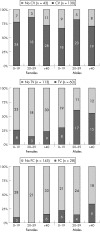Ocular manifestations of Fabry's disease: data from the Fabry Outcome Survey
- PMID: 16973664
- PMCID: PMC1857640
- DOI: 10.1136/bjo.2006.100602
Ocular manifestations of Fabry's disease: data from the Fabry Outcome Survey
Abstract
Background: Fabry's disease is an X-linked lysosomal storage disorder characterised by deficient activity of the enzyme alpha-galactosidase A.
Aim: To study eye abnormalities in patients with Fabry's disease in the Fabry Outcome Survey (FOS).
Methods: This is the largest study of ocular manifestations in patients with Fabry's disease. In all, 173 of the 688 patients enrolled in FOS underwent a detailed ophthalmic examination, with a special focus on abnormalities of the cornea, lens, conjunctival and retinal vessels.
Results: Cornea verticillata was reported in 76.9% of females and 73.1% of males; vessel tortuosity was observed in 21.9% of females and in 48.7% of males. Fabry cataract was recorded in 9.8% of females and in 23.1% of males. Cornea verticillata was therefore the most frequently reported ophthalmic abnormality in Fabry's disease in both hemizygotic males and heterozygotic females. Tortuous conjunctival and retinal vessels and Fabry cataract were more frequently found in males than in females. Vessel tortuosity was more frequently observed in patients with a higher severity score and greater impairment of renal and cardiac function, suggesting that it may be associated with a more severe disease. The youngest patient with ocular changes was 3 years old. The prevalence of tortuous vessels in males increased with age.
Conclusion: The presence of cornea verticillata is a useful aid in the diagnosis of Fabry's disease, as it is often present at the time of diagnosis. Vessel tortuosity may have some predictive value for systemic involvement.
Conflict of interest statement
Competing interests: None.
References
-
- Germain D P. Fabry's disease (alpha‐galactosidase‐A deficiency): recent therapeutic innovations. J Soc Biol 2002196183–190. - PubMed
-
- Hauser A C, Lorenz M, Sunder‐Plassmann G. The expanding clinical spectrum of Anderson‐Fabry disease: a challenge to diagnosis in the novel era of enzyme replacement therapy. J Intern Med 2004255629–636. - PubMed
-
- Desnick R J, Ioannou Y A, Eng C M. Alpha‐galactosidase A deficiency: Fabry disease. In: Scriver CR, et al eds. The metabolic and molecular basis of inherited disease. New York: McGraw‐Hill, 200137–74.
-
- Pastores G M, Thadhani R. Advances in the management of Anderson‐Fabry disease: enzyme replacement therapy. Expert Opin Biol Ther 20022325–333. - PubMed
Publication types
MeSH terms
LinkOut - more resources
Full Text Sources
Medical






